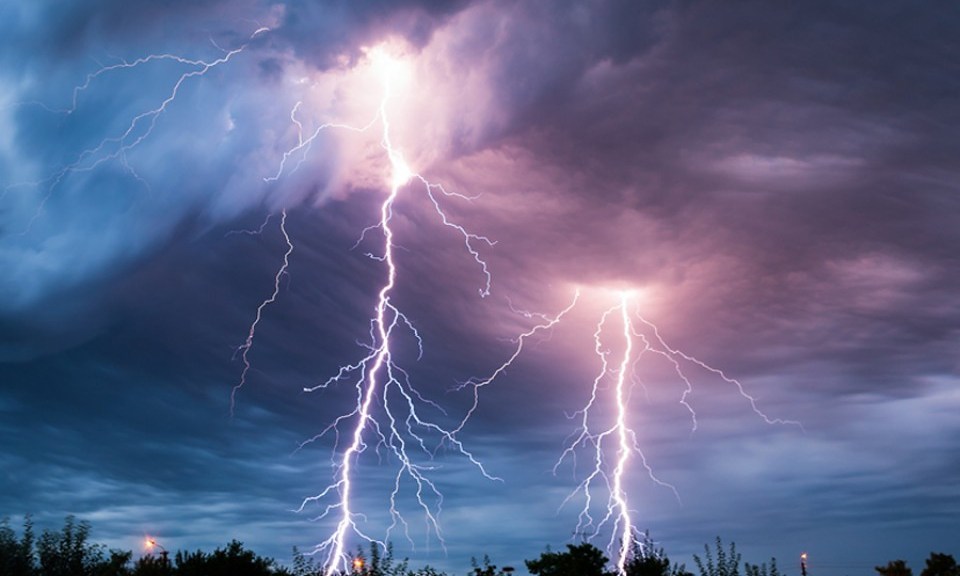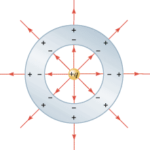most known and powerful display of electrostatics in nature is a lightning storm. Lightning storms are inescapable from humankind’s attention. They are never invited, never planned and never gone unnoticed. The rage of a lightning strike will wake a person in the middle of the night. They send children rushing into parent’s bedrooms, crying for assurance that everything will be safe. The fury of a lightning strike is capable of interrupting midday conversations and activities. They’re the frequent cause of canceled ball games and golf outings. Children and adults alike crowd around windows to watch the lightning displays in the sky, standing in awe of the power of static discharges. Indeed, a lightning storm is the most powerful display of electrostatics in nature.
In this part of Lesson 4, we will ponder two questions:
· What is the cause and mechanism associated with lightning strikes?
· How do lightning rods serve to protect buildings from the devastating effects of a lightning strike?
Static Charge Buildup in the Clouds
The scientific community has long pondered the cause of lightning strikes. Even today, it is the subject of a good deal of scientific research and theorizing. The details of how a cloud becomes statically charged are not completely understood (as of this writing). Nonetheless there are several theories that make a good deal of sense and that demonstrate many concepts previously discussed in this unit of The Physics Classroom.
The precursor of any lightning strike is the polarization of positive and negative charges within a storm cloud. The tops of the storm clouds are known to acquire an excess of positive charge and the bottoms of the storm clouds acquire an excess of negative charge. Two mechanisms seem important to the polarization process. One mechanism involves a separation of charge by a process that bears resemblance to frictional charging. Clouds are known to contain countless millions of suspended water droplets and ice particles moving and whirling about in turbulent fashion. Additional water from the ground evaporates, rises upward and forms clusters of droplets as it approaches a cloud. This upwardly rising moisture collides with water droplets within the clouds. In the collisions, electrons are ripped off the rising droplets, causing a separation of negative electrons from a positively charged water droplet or a cluster of droplets.
The second mechanism that contributes to the polarization of a storm cloud involves a freezing process. Rising moisture encounters cooler temperatures at higher altitudes. These cooler temperatures cause the cluster of water droplets to undergo freezing. The frozen particles tend to cluster more tightly together and form the central regions of the cluster of droplets. The frozen portion of the cluster of rising moisture becomes negatively charged and the outer droplets acquire a positive charge. Air currents within the clouds can rip the outer portions off the clusters and carry them upward toward the top of the clouds. The frozen portion of the droplets with their negative charge tends to gravitate towards the bottom of the storm clouds. Thus, the clouds become further polarized.
 These two mechanisms are believed to be the primary causes of the polarization of storm clouds. In the end, a storm cloud becomes polarized with positive charges carried to the upper portions of the clouds and negative portions gravitating towards the bottom of the clouds. The polarization of the clouds has an equally important effect on the surface of the Earth. The cloud’s electric field stretches through the space surrounding it and induces movement of electrons upon Earth. Electrons on Earth’s outer surface are repelled by the negatively charged cloud’s bottom surface. This creates an opposite charge on the Earth’s surface. Buildings, trees and even people can experience a buildup of static charge as electrons are repelled by the cloud’s bottom. With the cloud polarized into opposites and with a positive charge induced upon Earth’s surface, the stage is set for Act 2 in the drama of a lightning strike.
These two mechanisms are believed to be the primary causes of the polarization of storm clouds. In the end, a storm cloud becomes polarized with positive charges carried to the upper portions of the clouds and negative portions gravitating towards the bottom of the clouds. The polarization of the clouds has an equally important effect on the surface of the Earth. The cloud’s electric field stretches through the space surrounding it and induces movement of electrons upon Earth. Electrons on Earth’s outer surface are repelled by the negatively charged cloud’s bottom surface. This creates an opposite charge on the Earth’s surface. Buildings, trees and even people can experience a buildup of static charge as electrons are repelled by the cloud’s bottom. With the cloud polarized into opposites and with a positive charge induced upon Earth’s surface, the stage is set for Act 2 in the drama of a lightning strike.
The Mechanics of a Lightning Strike
As the static charge buildup in a storm cloud increases, the electric field surrounding the cloud becomes stronger. Normally, the air surrounding a cloud would be a good enough insulator to prevent a discharge of electrons to Earth. Yet, the strong electric fields surrounding a cloud are capable of ionizing the surrounding air and making it more conductive. The ionization involves the shredding of electrons from the outer shells of gas molecules. The gas molecules that compose air are thus turned into a soup of positive ions and free electrons. The insulating air is transformed into a conductive plasma. The ability of a storm cloud’s electric fields to transform air into a conductor makes charge transfer (in the form of a lightning bolt) from the cloud to the ground (or even to other clouds) possible.
A lightning bolt begins with the development of a step leader. Excess electrons on the bottom of the cloud begin a journey through the conducting air to the ground at speeds up to 60 miles per second. These electrons follow zigzag paths towards the ground, branching at various locations. The variables that affect the details of the actual pathway are not well known. It is believed that the presence of impurities or dust particles in various parts of the air might create regions between clouds and earth that are more conductive than other regions. As the step leader grows, it might be illuminated by the purplish glow that is characteristic of ionized air molecules. Nonetheless, the step leader is not the actual lightning strike; it merely provides the roadway between cloud and Earth along which the lightning bolt will eventually travel.
As the electrons of the step leader approach the Earth, there is an additional repulsion of electrons downward from Earth’s surface. The quantity of positive charge residing on the Earth’s surface becomes even greater. This charge begins to migrate upward through buildings, trees and people into the air. This upward rising positive charge – known as a streamer – approaches the step leader in the air above the surface of the Earth. The streamer might meet the leader at an altitude equivalent to the length of a football field. Once contact is made between the streamer and the leader, a complete conducting pathway is mapped out and the lightning begins. The contact point between ground charge and cloud charge rapidly ascends upward at speeds as high as 50 000 miles per second. As many as a billion trillion electrons can transverse this path in less than a millisecond. This initial strike is followed by several secondary strikes or charge surges in rapid succession. These secondary surges are spaced apart so closely in time that may appear as a single strike. The enormous and rapid flow of charge along this pathway between the cloud and Earth heats the surrounding air, causing it to expand violently. The expansion of the air creates a shockwave that we observe as thunder.
downward from Earth’s surface. The quantity of positive charge residing on the Earth’s surface becomes even greater. This charge begins to migrate upward through buildings, trees and people into the air. This upward rising positive charge – known as a streamer – approaches the step leader in the air above the surface of the Earth. The streamer might meet the leader at an altitude equivalent to the length of a football field. Once contact is made between the streamer and the leader, a complete conducting pathway is mapped out and the lightning begins. The contact point between ground charge and cloud charge rapidly ascends upward at speeds as high as 50 000 miles per second. As many as a billion trillion electrons can transverse this path in less than a millisecond. This initial strike is followed by several secondary strikes or charge surges in rapid succession. These secondary surges are spaced apart so closely in time that may appear as a single strike. The enormous and rapid flow of charge along this pathway between the cloud and Earth heats the surrounding air, causing it to expand violently. The expansion of the air creates a shockwave that we observe as thunder.
Lightning Rods and Other Protective Measures
 Tall buildings, farmhouses and other structures susceptible to lightning strikes are often equipped with lightning rods. The attachment of a grounded lightning rod to a building is a protective measure that is taken to protect the building in the event of a lightning strike. The concept of a lightning rod was originally developed by Ben Franklin. Franklin proposed that lightning rods should consist of a pointed metal pole that extends upward above the building that it is intended to protect. Franklin suggested that a lightning rod protects a building by one of two methods. First, the rod serves to prevent a charged cloud from releasing a bolt of lightning. And second, the lightning rod serves to safely divert the lightning to the ground in event that the cloud does discharge its lightning via a bolt. Franklin’s theories on the operation of lightning rods have endured for a couple of centuries. And not until the most recent decades have scientific studies provided evidence to confirm the manner in which they operate to protect buildings from lightning damage.
Tall buildings, farmhouses and other structures susceptible to lightning strikes are often equipped with lightning rods. The attachment of a grounded lightning rod to a building is a protective measure that is taken to protect the building in the event of a lightning strike. The concept of a lightning rod was originally developed by Ben Franklin. Franklin proposed that lightning rods should consist of a pointed metal pole that extends upward above the building that it is intended to protect. Franklin suggested that a lightning rod protects a building by one of two methods. First, the rod serves to prevent a charged cloud from releasing a bolt of lightning. And second, the lightning rod serves to safely divert the lightning to the ground in event that the cloud does discharge its lightning via a bolt. Franklin’s theories on the operation of lightning rods have endured for a couple of centuries. And not until the most recent decades have scientific studies provided evidence to confirm the manner in which they operate to protect buildings from lightning damage.
The first of Franklin’s two proposed theories is often referred to as the lightning dissipation theory. According to the theory, the use of a lightning rod on a building protects the building by preventing the lightning strike. The idea is based upon the principle that the electric field strength is great around a pointed object. The intense electric fields surrounding a pointed object serve to ionize the surrounding air, thus enhancing its conductive ability. The dissipative theory states that as a storm cloud approaches, there is a conductive pathway established between the statically charged cloud and the lightning rod. According to the theory, static charges gradually migrate along this pathway to the ground, thus reducing the likelihood of a sudden and explosive discharge. Proponents of the lightning dissipation theory argue that the primary role of a lightning rod is to discharge the cloud over a longer length of time, thus preventing the excessive charge buildup that is characteristic of a lightning strike.
The second of Franklin’s proposed theories on the operation of the lightning rod is the basis of thelightning diversion theory. The lightning diversion theory states that a lighting rod protects a building by providing a conductive pathway of the charge to the Earth. A lightning rod is typically attached by a thick copper cable to a grounding rod that is buried in the Earth below. The sudden discharge from the cloud would be drawn towards the elevated lightning rod but safely directed to the Earth, thus preventing damage from occurring to the building. The lightning rod and the attached cable and ground pole provide a low resistance pathway from the region above the building to the ground below. By diverting the charge through the lightning protection system, the building is spared of the damage associated with a large quantity of electric charge passing through it.
Lightning researchers are now generally convinced that the lightning dissipation theory provides an inaccurate model of how lightning rods work. It is indeed true that the tip of a lightning rod is capable of ionizing the surrounding air and making it more conductive. However, this effect only extends for a few meters above the tip of the lightning rod. A few meters of enhanced conductivity above the tip of the rod is not capable of discharging a large cloud that stretches over several kilometers of distance. Unfortunately, there are currently no scientifically verified methods of lightning prevention. Furthermore, recent field studies have further shown that the tip of the lightning rod does not need to be sharply pointed as Ben Franklin suggested. Blunt-tipped lightning rods have been found to be more receptive to lightning strikes and thus provide a more likely path of discharge of a charged cloud. When installing a lightning rod on a building as a lightning protection measure, it is imperative that the rod be elevated above the building and connected by a low resistance wire to the ground.
Check Your Understanding
Use your understanding to answer the following questions. When finished, click the button to view the answers.
1. TRUE or FALSE:
The presence of lightning rods on top of buildings prevents a cloud with a static charge buildup from releasing its charge to the building.
See Answer

Answer: FALSE
Contrary to a commonly held belief, a lightning rod does not serve to prevent a lightning bolt. The presence of the rod on the building can only serve to divert the charge in the bolt to the ground through a low resistance pathway and thus protect the building from the damage which would otherwise result.
2. TRUE or FALSE:
If you place a lightning rod on top of your home but failed to ground it, then you home would still be safe in the unlikely event of a lightning strike..
See Answer

Answer: False
The presence of an elevated lightning rod could serve to draw charge from the cloud to the ground. In the event of a lightning strike, a bolt would likely select a path from the cloud that ultimately connects to the rod. If the rod is not grounded, then the charge would likely pass through the home during its journey to the ground. The intense heat associated with the lightning bolt would cause severe damage and possibly cause an explosion or a fire. In the end, it would have been better to not even have installed a lightning rod than to have installed one that is not grounded.


